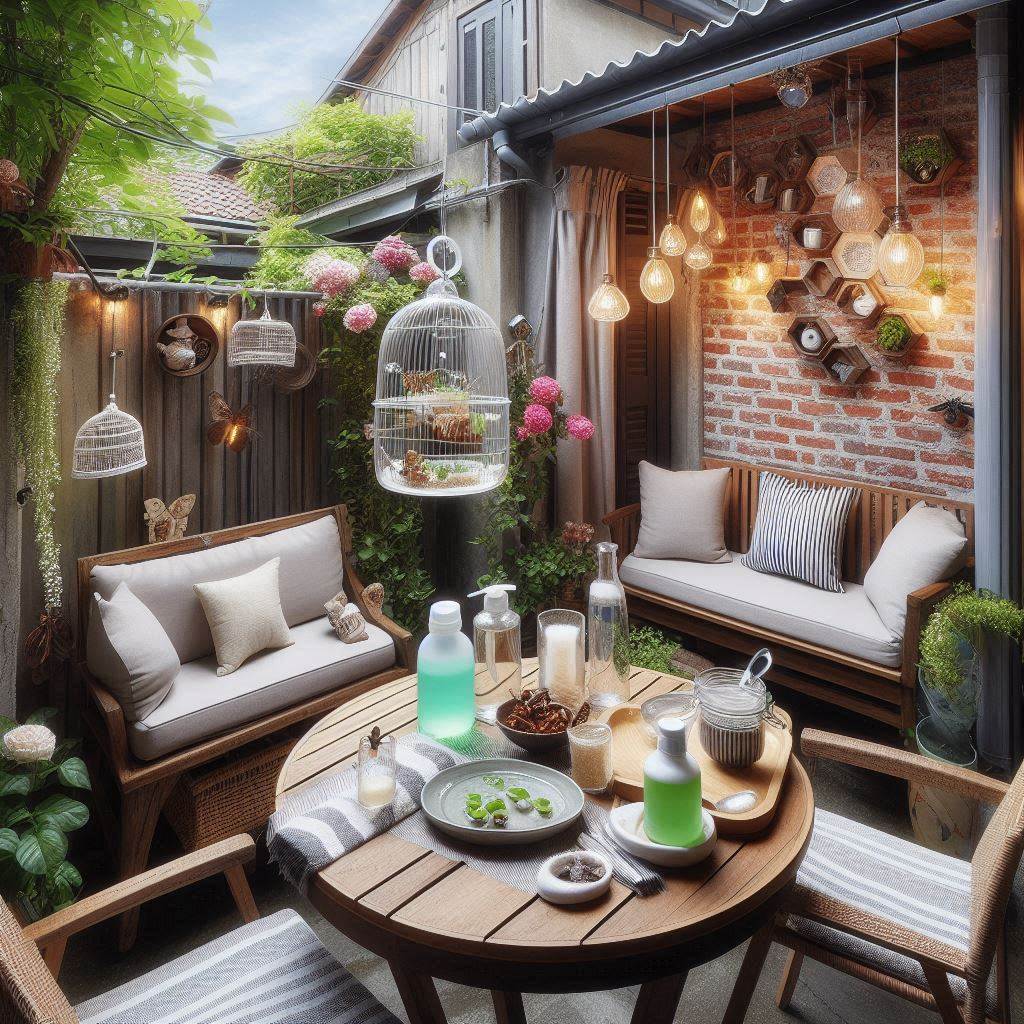There’s nothing quite like enjoying a refreshing drink or a delicious meal on your patio. But pesky flies can quickly turn that idyllic scene into a swatting frenzy. These buzzing, disease-carrying insects not only disrupt your relaxation, but they can also pose a health risk.
The good news is, there are several effective ways to reclaim your patio and create a fly-free haven. This guide explores the reasons flies find your patio attractive and equips you with 11 powerful tips to keep them at bay.
Why Flies Love Your Patio
Before tackling the flies themselves, it’s important to understand what draws them to your patio in the first place. Here are some common culprits:
- Food and Drinks: Flies are attracted to the smell of anything even remotely edible or sweet. Spilled drinks, leftover crumbs, and even the enticing aroma from your barbecue can be a dinner bell for these unwanted guests.
- Garbage and Compost: Leftovers, rotting fruit peels, and overflowing garbage bins are a fly buffet. The strong decomposition odors act as a beacon, guiding them straight to your patio.
- Pet Waste: Just like us, flies find pet waste unpleasant. However, that doesn’t stop them from being drawn to it. The smell of pet waste signals a potential breeding ground for these insects.
- Stagnant Water: Flies require moisture to survive. Puddles, clogged drains, and even birdbaths can become breeding grounds if left unattended.
11 Powerful Tips to Eliminate Flies from Your Patio
Now that you know why flies find your patio so inviting, it’s time to turn the tables. Here are 11 effective tips to create a fly-free zone:
Tip 1: Eliminate Fly Attractants – Practice Patio Hygiene

The first line of defense is to remove anything that might attract flies. Here’s what you can do:
- Clean Up Food and Drinks: This seems obvious, but it’s crucial. Don’t leave leftover food or drinks on your patio furniture. Clean spills immediately and wipe down surfaces after meals.
- Secure Trash Cans and Compost Bins: Flies can easily squeeze through small openings. Use tightly sealed trash cans with lids that stay shut. Consider lining your bins with well-fitting bags and replace them regularly. For compost bins, ensure proper ventilation to avoid attracting flies with strong odors.
- Pick Up Pet Waste Regularly: Don’t let pet waste accumulate on your patio. Pick it up promptly and dispose of it properly. This eliminates a breeding ground for flies and removes a source of attraction.
Tip 2: Embrace the Power of Natural Fly Repellents

Nature offers a variety of plants and scents that repel flies. Here’s how to harness their power:
- Plant Fly-Repelling Herbs: Transform your patio into a fly-free haven by planting herbs known to deter these insects. Consider basil, mint, lavender, or citronella grass. These fragrant herbs not only add beauty to your patio but also provide a natural defense against flies.
- Scatter Cloves or Use Essential Oils: The pungent aroma of cloves is a natural fly repellent. Place whole cloves in small bowls strategically around your patio or soak cotton balls in essential oils like citronella, lemongrass, or peppermint and place them in similar spots. Refresh the cloves or reapply the essential oils regularly for sustained effectiveness.
- Deploy Vinegar Traps (for Fruit Flies): Fruit flies are particularly attracted to the sweet smell of vinegar. Create a simple trap by filling a small jar halfway with apple cider vinegar. Add a few drops of dish soap to break the surface tension. The flies will be drawn to the vinegar’s scent and get trapped in the soapy mixture.
Tip 3: Deploy Traps and Baits – Attract and Eliminate

If natural repellents aren’t enough, consider using commercial fly traps and baits. These come in various forms, each with its own advantages:
- Fly Traps: These hanging or standing traps use a combination of attractants and sticky surfaces to trap flies. Choose traps with attractants suitable for the type of flies you’re targeting (e.g., house flies, fruit flies).
- Fly Baits: These baits are typically placed in containers with small openings. Flies enter the container, lured by the bait, and become trapped or poisoned. Be sure to place fly baits strategically, away from areas where you eat or relax, and follow the manufacturer’s instructions carefully, especially if you have pets or children around.
Tip 4: Create a Smoke Barrier – A Time-Tested Approach

While not as effective as other methods, creating a smoke barrier can help deter flies. Here’s what you can try:
Citronella Candles or Incense Sticks: Citronella oil, a natural insect repellent, is a common ingredient in outdoor candles and incense sticks. Burning these on your patio can create a smoke barrier that some flies find unpleasant. While not the most long-lasting solution, it can offer temporary relief, especially during evening gatherings.
Tip 5: Consider Fly Repellent Sprays – A Targeted Approach

For immediate relief or stubborn fly infestations, outdoor-safe fly repellent sprays can be a powerful tool. However, it’s important to use them judiciously:
- Choose Outdoor-Safe Sprays: Look for sprays specifically designed for outdoor use. These formulas are typically less concentrated than indoor sprays and are less likely to harm plants or beneficial insects.
- Target Fly Hiding Spots: Focus spraying on areas where flies tend to congregate, such as under furniture, around trash cans, or near doorways. Avoid spraying directly on food or surfaces where you’ll be eating.
- Follow Safety Instructions: Always read and follow the manufacturer’s instructions carefully when using any repellent spray. Pay attention to recommended application rates, safety precautions, and reapplication times.
Tip 6: Address Underlying Problems – Deal with the Source

Sometimes, the fly problem on your patio might be a symptom of a larger issue. Here’s what to consider:
- Check for Breeding Sites: Flies breed in moist, organic matter. Look for potential breeding sites around your patio, such as clogged drains, overflowing gutters, or even small pockets of stagnant water. Address these issues to prevent flies from multiplying near your outdoor space.
- Seal Entry Points: Flies can sneak into your patio through small cracks or gaps around doors and windows. Inspect these areas and seal any openings with caulk or weather stripping.
Tip 7: Be Persistent – The Key to a Fly-Free Patio

Getting rid of flies might require a multi-pronged approach and consistent effort. Here’s why persistence is key:
- Flies Reproduce Quickly: A single female fly can lay hundreds of eggs in her lifetime. So, eliminating a small population early on can prevent a full-blown infestation later.
- Attractants Linger: Even after cleaning up food and drinks, residual odors might still linger and attract flies. Consistent cleaning and sanitation are crucial.
- Natural Repellents Need Refreshing: The effectiveness of natural repellents like essential oils or vinegar traps diminishes over time. Refresh them regularly to maintain their effectiveness.
Tip 8: Leverage the Power of Fans – Create a Fly Disruption Zone

Flies are weak flyers and struggle to navigate strong air currents. Here’s how to use fans to your advantage:
- Deploy Outdoor Fans: Strategically place oscillating fans around your patio. The constant airflow disrupts flies’ flight patterns, making it difficult for them to land or linger in your space. Consider using portable floor fans or even ceiling fans on covered patios.
- DIY Fly Repellent Fan: For a more targeted approach, create a DIY fly repellent fan. Attach zip-lock bags filled with a few drops of essential oils like citronella or lemongrass to a standing fan. As the fan rotates, it disperses the fly-repelling scent throughout your patio.
Tip 9: Embrace the Beauty and Utility of Fly-Repellent Plants

Nature offers a variety of beautiful plants that not only enhance your patio’s aesthetics but also deter flies. Here are some additional options to explore:
- Venus Flytrap: This unique carnivorous plant not only adds a conversation starter to your patio but also actively traps and consumes flies. However, keep in mind that Venus flytraps require specific care and might not be suitable for all climates.
- Marigolds: These vibrant yellow flowers not only add a burst of color but also possess a natural fly-repelling scent. Consider planting marigolds in pots around your patio perimeter for added visual appeal and fly deterrence.
- Catnip: While beloved by cats, catnip’s strong aroma is unpleasant to flies. Plant catnip in strategic locations on your patio, keeping in mind its potential effect on your feline companions.
Tip 10: Light Up the Night – Strategic Lighting for Fly Control

Flies are primarily active during the day. Here’s how to use strategic lighting to make your patio less fly-friendly at night:
- Minimize Patio Lighting: While enjoying your patio in the evening, use minimal lighting. Bright lights can attract night-flying insects like moths, which in turn might attract fly predators like spiders. Opt for softer, more diffused lighting if needed.
- Switch to Yellow Light Bulbs: Consider replacing your patio lights with yellow or amber-colored bulbs. These bulbs are less attractive to flies compared to white or blue light bulbs.
Tip 11: Embrace DIY Fly Traps – Homemade Solutions

If you’re looking for a budget-friendly approach, consider creating your own DIY fly traps:
- The Plastic Bottle Trap: Cut a plastic bottle in half, then invert the top portion and secure it inside the bottom half like a funnel. Add a bait like fruit scraps or leftover juice to the bottom section. The flies will enter the trap through the funnel, lured by the bait, and struggle to find their way out.
- The Soap and Water Trap: Fill a shallow dish with soapy water and add a few drops of dish soap. The soap breaks the surface tension of the water, causing flies that land on it to get stuck.
Remember, consistency is key when using DIY traps. Refresh the bait or water regularly to maintain their effectiveness.
Reclaim Your Patio and Enjoy the Outdoors
Simply follow these tips and adopt a proactive approach to effectively eliminate flies from your patio and create a relaxing, pest-free haven. Remember, the key lies in removing attractants, utilizing repellents, and addressing underlying problems. With a little effort, you can reclaim your patio and enjoy the fresh air and sunshine without the constant buzz of unwelcome guests.
Here are some additional points to consider:
- Combine Methods: Don’t rely on just one method. Combine several strategies for a more comprehensive approach.
- Safety First: When using any traps, baits, or sprays, prioritize safety, especially if you have pets or children around.
- Professional Help: For severe fly infestations, consider seeking assistance from a professional pest control service.
With these strategies and a little persistence, you can transform your patio into a fly-free oasis, allowing you to truly enjoy the beauty of the outdoors. So, grab a drink, relax in your comfortable chair, and breathe in the fresh air – fly-free!

